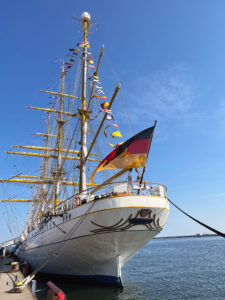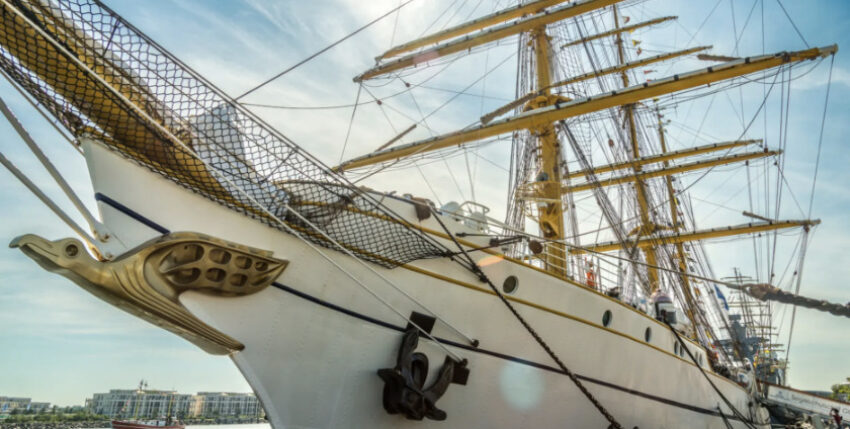A moment of carelessness and a wave took me off my tired legs and I slid roughly across the wooden deck. Somewhat shocked and dripping, I heard the boatswain shouting at me in the wind through the water in my ears "All right? Then watch sailor - to the sheet!"
There we pulled on the rope with a loud rhythm "fetch away". This went on for hours. It wasn't an exercise or a harassing drill, but a battle with a storm. What were harmless lines on the chart below deck in meteorology were harsh reality up here. Why do people do this to themselves? Sailing as a summer pastime or as an Olympic discipline is understandable, but on an archaic three-master? Is a tall ship that can only be navigated with many well-coordinated hands, concentrated minds, a great deal of skill and a good deal of courage still in keeping with the times? What are the benefits of being able to mould a floating school from an ancient, complex principle of locomotion?
Yes, it is an anachronism, where the epitome of happiness can be a simple hammock and muscle power is often superior to hydraulics. Under sail there is no escape, no single cabin, no internet and rarely anything like closing time. This is precisely why hopeful citizen children are sent into this perma-humid and occasionally foul-smelling world, where bruises and bloody hands are commonplace. They are expected to follow theoretical lessons after sea watches despite a lack of sleep, even if this provokes some individual psyches to bursting point.

All navies and many sailing schools around the world teach their young sailors on sailing school ships what salt water tastes like, what cold or even galley service feels like. They also learn how to overcome fear and how to separate courage from cockiness. It is basic training for the sea, a mosaic of character development, a formative building block on the path to leadership. Those who have experienced and passed it are prepared for extreme situations. Anyone who wants to become a decision-maker should have experienced the consequences. That's all you really need to explain.
The concept is always the same: the individual should learn to see themselves as part of a whole, regardless of their biography. There is an elementary pick-up point for everyone. Even for those who do not choose the sea as their workplace, it will forever remain a treasure from which to draw and which enables them to have their say. With the end of the sailing ship era at the end of the century before last and the fading cargo clipper era in the 20th century, windjammers nevertheless remained on all the world's oceans. Sometimes as exclusive cruisers such as the Sea Cloud or, for paying sailors, the Alexander von Humboldt.
The most prominent tall ships are the sail training ships of several navies. They include Argentina's Libertad, Italy's Amerigo Vespucci, Norway's Christian Radich and Spain's Juan Sebastian de Elcano. France has two schooners, the Belle Poule and the Étoile, and the Danish merchant fleet has the Danmark. The German design of the Gorch Fock class of the 1930s by Blohm+Voss can be found in the Eagle of the US Coast Guard, the Mircea of Romania and the Portuguese Sagres. This far from exhaustive list proves that sailing is established worldwide as a skill and a teaching profession, because with advancing technology comes the danger of alienation from the craft. Nautical science is becoming increasingly digital, but the sea needs to be mastered with humility before the forces. It is not just a matter of parrying the failure of a satellite with old navigation equipment, for example, but of moulding individuals into a team. We are not talking about the casual eight-hour office ensemble, but the crew that can survive in a hostile environment. Every cent invested in this training pays off later on the command bridges of much larger and more expensive ships, be they submarines, frigates or container freighters.
It is therefore no coincidence that sail training ships are maintained and cultivated as a tradition and that new builds have been launched worldwide, such as the new Becks' ship, the Polish Mir or the Indian Tarangini. The Chinese navy is also planning newbuildings, with a concept and programme based on the German model. For decades, these marvellous silhouettes have been visiting foreign ports around the world, decked out in their finest finery and peacefully representing their country. They are visited and marvelled at in droves. Every man and every woman who yesterday cursed the drudgery of the masts is proud to be a part of it forever - each and every one an ambassador for their country. This is precisely why the foreign ministries instruct where the journey is to go and where state guests are to be received. It's not just the prestige of a navy, but also a reflection of a country's armed forces and the nation itself. Tall ships make an impression. This is not an end in itself.
The article was published in "Europäische Sicherheit & Technik" in January 2019.
Technical data of the German sail training ship Gorch Fock
Name: Gorch Fock II: sister ship of the first Gorch Fock built in 1933
Naming: Named after the writer Gorch Fock (Johann Wilhelm Kinau)
Commissioning: 1958
Home harbour: Keel
Berth: Gorch-Fock pier (before 2021 Tirpitz pier)
Nautical miles travelled up to January 2011: 741.106
Construction method: Steel hull
Mast height in the foretop: 45 m
Mast height main top: 44,90 m
Mast height Besantopp: 39,80 m
The 23 sails of the Sail training ship The masts are divided as follows: ten square sails, six staysails, four foresails, two mizzen sails and one mizzen topsail, the respective spars are 24 metres long at the foresail and main yard, the bowsprit measures 18.8 metres, 8.9 of which are in front of the bow, and the mizzen boom 16.4 metres. The bowsprits of the two forward masts are set up for foresailing to enable the ship to navigate the Kiel Canal. In the meantime, the ship has been fitted with additional "trimmings" with a slightly different cut, increasing the total area of the sails to around 2000 square metres.
The prefix SSS, which appears regularly in the literature, means sail training ship.
More about the Sail training ship Gorch Fock on Wikipedia: https://de.wikipedia.org/wiki/Gorch_Fock_(Schiff,_1958)










